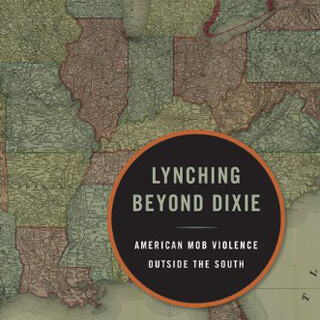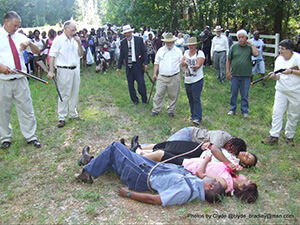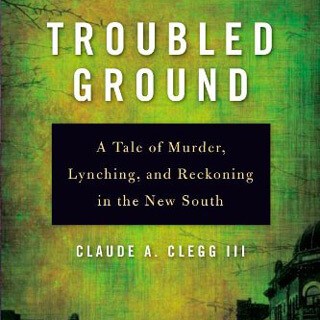Overview
Amy Louise Wood revisits an operahouse lynching in Livermore, Kentucky.
Essay
On a spring evening in 1911, a mob of about fifty white men in the small city of Livermore, Kentucky, lynched Will Potter on the stage of the local opera house. Potter was the black manager of a segregated poolroom where Clarence Mitchell, a young white liveryman, and a friend had come to play. When they refused to pay, Potter asked them to leave, explaining, according to one local report, that "a negro poolroom is not the place for white men." A fight ensued, and Mitchell left the poolroom, "cursing" Potter and daring him to come out. Potter "walked to the door with a pistol in his hands and fired two shots." The city marshal almost immediately arrested Potter and brought him to the theater, securing him in a dressing room behind the stage. As news of the incident spread throughout the town, a mob of "infuriated citizens" formed and broke into the opera house, overpowering the marshal and his deputies. The men then took Potter to the center of the stage, tied him down, and turned on the footlights. Arranging themselves in the orchestra pit, they, on cue, began to shoot.1News accounts of the fight and the subsequent lynching differ. This account of the fight, which presents Mitchell as the instigator, is from the Owensboro (Ky.) Daily Inquirer, 21 Apr. 1911, 1. Owensboro is a small city located near Livermore, in the western region of the state. A border state, Kentucky had relatively high rates of racial violence, especially in western and central Kentucky, where African Americans were more highly concentrated than in the eastern counties, and where white Kentuckians were more likely to identify themselves as southern. See George C. Wright, Racial Violence in Kentucky (Baton Rouge: Louisiana State University Press, 1990) 5, 70–72, 118–19. "Of about 200 shots fired, nearly half entered the body of the black man," reported the Louisville (Ky.) Courier-Journal. "The remainder tore to shreds the woodland scenery, arranged for the presentation of a more mild drama." Recognizing that the lynching itself was theater, the news account went on to exclaim that "the little Operahouse at Livermore . . . never witnessed such a melodrama."2Louisville (Ky.) Courier-Journal, 21 Apr. 1911, 1. According to the Owensboro (Ky.) Daily Inquirer, Potter was lynched on stage by the light of lanterns, not footlights.
The lynching of Will Potter was not a mass spectacle lynching; that is, there were no crowds of spectators there to witness a mob of fifty white men avenging an attempted murder. But if photographing a lynching staged for the camera exaggerated images of white virtue and black degeneracy, the lynching of Potter placed in macabre relief the ways in which white southerners perceived lynching as a staged performance, a "melodrama" in which white righteousness triumphed over black villainy. That Potter was lynched in an opera house may appear to be an unfortunate coincidence, except that the mob did not simply shoot Potter where it found him. The lynchers evidently saw the dramatic potential of their violence; even without a crowd of supporters and spectators, they chose to turn on the "glaring footlights" of the stage and position Potter center stage. And by placing themselves in the orchestra pit rather than on stage with Potter, they positioned themselves as both performers and audience — spectators to their own drama.3Louisville (Ky.) Courier-Journal, 21 Apr. 1911, 1.
News reporters made much of this "melodrama" at the opera house, so that an otherwise all too typical lynching became national, and even international, news. The story, for instance, appeared in a Paris newspaper, Le Petit Journal, along with a drawing depicting the scene. "Whatever else may be said about the inhabitants of Livermore, Ky., it cannot be denied that in them the dramatic sense is strongly developed," opined the New York Times, "for, when they deemed it expedient to lynch a negro, they managed to do the familiar deed in a way not only entirely, but highly picturesque in the literal meaning of that much-abused word." Other accounts exaggerated the event, reporting that the mob had seized Potter from the jail and taken him to the opera house. According to these reports, the mob charged admission to the lynching and allowed those who had purchased orchestra seats to empty their guns into Potter, while those in the gallery were permitted only one shot each. This sensational attention ultimately led the "better elements" of Livermore to "deeply deplore the action of the mob" and support a legal indictment against "the members of the lawless band" to, according to the county attorney, "erase the blot on the fair name" of the county.4Wright, Racial Violence in Kentucky, 118, 165; NYT, 22 Apr. 1911, 12; Louisville (Ky.) Courier-Journal, 13 May 1911, 1. The NAACP wrote to both President Taft and Kentucky governor Augustus Wilson in protest. This national attention compelled Governor Wilson to write to the NAACP to express his opposition to injustice and mob action but also to clarify that the lynching, "while it was bad enough," was not as bad or as sensationalistic as reported. Although indictments were made, no one was ever convicted for the lynching. Crisis, June 1911, 61.
This turn of events was also undoubtedly influenced by the fact that the whole affair began in an amusement hall of ill repute associated with African American men — the poolroom where Potter and Mitchell fought. The "better elements" of Livermore could easily abandon their support for a mob that rallied after a brawl in a poolroom operated for blacks. After all, according to the Owensboro (Ky.) Daily Inquirer, the fight began because Potter attempted to uphold Jim Crow segregation by telling Mitchell that "a negro poolroom is not the place for white men." Nevertheless, despite Mitchell's occupation as a liveryman and his presence at the pool hall, most papers initially represented him, as they did most white victims in these cases, as a "prominent citizen of the little town" who showed restraint against Potter's aggression. The lynchers, the ones who were indicted at least, were not the poorest in town — several of these men were able to, or had friends who could, post their bonds of $500 or $1,000 — but neither were they well established or well respected. They were skilled laborers, like Mitchell, or small business owners, all "well-known" young men, except for W. N. Davis, a sixty-year-old man engaged in the "restaurant business." Two of the "leaders" were Clifton Schroeter, the proprietor of a "floating" photography studio, and Jesse Schroeter, also a photographer.5Owensboro (Ky.) Daily Inquirer, 21 Apr. 1911, 1; Louisville (Ky.) Courier-Journal, 13 May 1911, 1. The Owensboro (Ky.) Daily Inquirer initially reported that Mitchell was a troublemaker and a "Negro-hater" and that the mob was "composed of young hot-headed fellows, and not of the older and very best citizens of the town." But it also made note that Mitchell's father was "well-respected by those who knew him." Owensboro (Ky.) Daily Inquirer, 21 Apr. 1911, 1.
By choosing to lynch Potter in the opera house, these men were in some sense recognizing the ways in which entertainment was bound up with violence, as well as the ways in which violence itself was a source of visual amusement. At the turn of the century, most southern cities and towns, even small towns like Livermore, had an opera house where white townspeople of all classes watched high dramas, vaudeville acts, minstrel shows, and, at times, motion pictures. In lynching Potter in the opera house, therefore, these working men were acclaiming their act of vengeance as respectable drama in a way that the poolroom brawl was decidedly not. 
About the Author
Amy Louise Wood is assistant professor of history at Illinois State University. This essay is adapted from Wood's Lynching and Spectacle: Witnessing Racial Violence in America, 1890-1940. Copyright 2009 by the University of North Carolina Press. Used by permission of the publisher. www.uncpress.unc.edu.
Recommended Resources
Allen, James. Without Sanctuary: Photographs and Postcards of Lynching in America.
http://www.withoutsanctuary.org/main.html
Brundage, W. Fitzhugh. Lynching in the New South: Georgia and Virginia, 1880-1930. Chicago: University of Illinois Press, 1993.
Dray, Philip. At the Hands of Persons Unknown: The Lynching of Black America. New York: Random House, Inc., 2002.
Pfeifer, Michael J. Rough Justice: Lynching and American Society, 1874-1947. Urbana: University of Illinois Press, 2004.
Waldrep, Christopher. The Many Faces of Judge Lynch: Extralegal Violence and Punishment in America. New York: Palgrave Macmillan, 2002.
Similar Publications
| 1. | News accounts of the fight and the subsequent lynching differ. This account of the fight, which presents Mitchell as the instigator, is from the Owensboro (Ky.) Daily Inquirer, 21 Apr. 1911, 1. Owensboro is a small city located near Livermore, in the western region of the state. A border state, Kentucky had relatively high rates of racial violence, especially in western and central Kentucky, where African Americans were more highly concentrated than in the eastern counties, and where white Kentuckians were more likely to identify themselves as southern. See George C. Wright, Racial Violence in Kentucky (Baton Rouge: Louisiana State University Press, 1990) 5, 70–72, 118–19. |
|---|---|
| 2. | Louisville (Ky.) Courier-Journal, 21 Apr. 1911, 1. According to the Owensboro (Ky.) Daily Inquirer, Potter was lynched on stage by the light of lanterns, not footlights. |
| 3. | Louisville (Ky.) Courier-Journal, 21 Apr. 1911, 1. |
| 4. | Wright, Racial Violence in Kentucky, 118, 165; NYT, 22 Apr. 1911, 12; Louisville (Ky.) Courier-Journal, 13 May 1911, 1. The NAACP wrote to both President Taft and Kentucky governor Augustus Wilson in protest. This national attention compelled Governor Wilson to write to the NAACP to express his opposition to injustice and mob action but also to clarify that the lynching, "while it was bad enough," was not as bad or as sensationalistic as reported. Although indictments were made, no one was ever convicted for the lynching. Crisis, June 1911, 61. |
| 5. | Owensboro (Ky.) Daily Inquirer, 21 Apr. 1911, 1; Louisville (Ky.) Courier-Journal, 13 May 1911, 1. The Owensboro (Ky.) Daily Inquirer initially reported that Mitchell was a troublemaker and a "Negro-hater" and that the mob was "composed of young hot-headed fellows, and not of the older and very best citizens of the town." But it also made note that Mitchell's father was "well-respected by those who knew him." Owensboro (Ky.) Daily Inquirer, 21 Apr. 1911, 1. |




